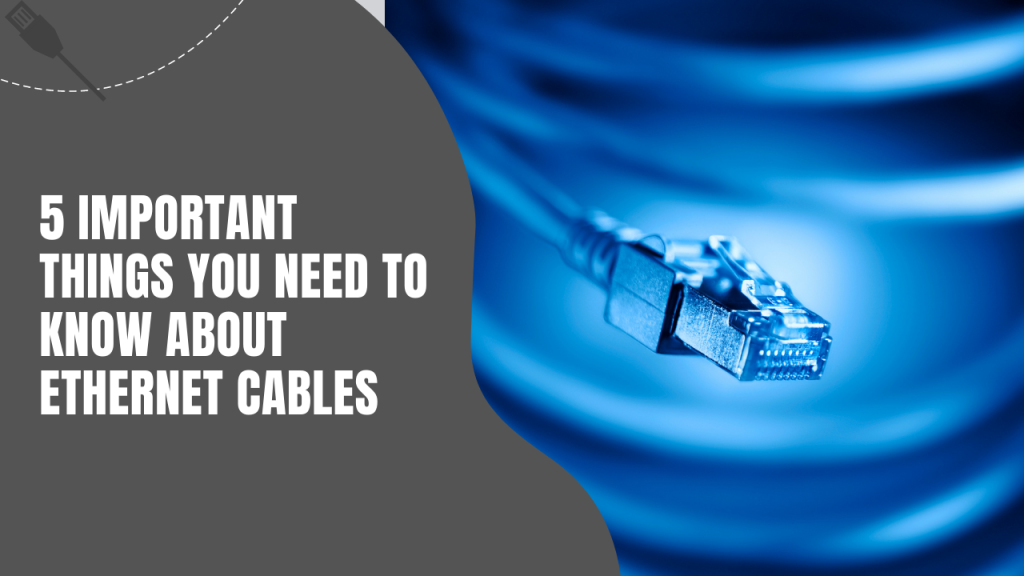Today, the internet is an important part of everyone’s life. Ethernet network cables are one of the technologies that make it possible. These little wires are responsible for allowing us to connect and access information from any device of our choosing. Ethernet network cables provide us with unmatched abilities in networking in today’s world and should not be taken for granted.
Here are five things you need to know about ethernet cables.
1. Ethernet Cables- Definition
In a network, Ethernet cables consist of twisted pairs of metal conductors, which are under a protective covering called a jacket. Ethernet cables serve a variety of purposes. The most common application of these cables is high-speed data transfer.
2. Categories of Ethernet Cables
There are seven categories of ethernet cables. But in this article, we will discuss the best and the widely used ones because the earlier categories are out of date now.
The following are the latest and most widely used categories of bulk Ethernet cables.
Cat5: These cables were rolled out to the market as an upgrade on Cat4 cables. Although still in use today, they are not the best ones out there. You can use them for home networks with minimum speed and bandwidth requirements.
Cat5e: These cables are an enhanced version of the 5th category. With a data transfer rate of up to 100Mbps over 100 meters and a bandwidth capacity of 350 MHz, Cat5e cables are a good choice for all sorts of home networks.
Cat6: These cables are very fast and extremely efficient. You can achieve speeds of up to 10 Gbps over 50 meters with Cat6 cables. The bandwidth ca[acity you get is 550 MHz, which is more than enough for most home and business applications.
Cat6A: The 6th augmented category ethernet cables are the favorite of every networking engineer. Cat6A cables support all high-speed ethernet applications such as 10BASE-T, 100BASE-TX Fast Ethernet, 1000BASE-T (IEEE802.3), 100VG-AnyLAN (IEEE802.12), 750 MHz Broadband Video Voice, T1, ISDN 155/ 622 Mbps ATM PoE (Power over Ethernet), and indoor voice, data, video, and security networking applications in general.
Cat7: 7th category ethernet cables have the same performance specifications as Cat6a cables. The only difference between the two of them is that Cat7 cables have enhanced resistance against resistances.
Cat8: The latest category of ethernet cable – Cat8 – has a mind-blowing bandwidth capacity. It provides up to 2000 MHz bandwidth which is almost three times more than its immediate predecessors. And the maximum data transfer rate supported by this cable is a whopping 40Gbps.
However, the features of this cable are only limited to short cable run lengths and it is only useful in data centers. For home and office networks, Cat6/a and Cat7 are still the most ideal choices.
3. STP vs UTP Ethernet Cables
You will find two types of ethernet cables: A shielded twisted pair (STP) and unshielded twisted pair (UTP). STP cable conductors are twisted tightly in pairs to reduce the various types of interference. They are shielded by a thin metal sheathing or any other material to further their resistance against EMI and external noise.
The shielding of ethernet cable conductors adds to their cost and is slightly more expensive than UTP cables. If you can afford a few more dollars, you should always pick STP ethernet network cables.
UTP cables also feature conductors tightly twisted in pairs for resistance against interference. However, they do not have a shield around the conductors against EMI and crosstalk. In high-density networks, it can be a bit troublesome, but in low-density networks, these cables work just fine.
4. Ethernet cable conductors
There are two types of conductors in ethernet cables. Copper-clad aluminum conductors and bare copper conductors.
Copper-Clad Aluminum conductors are made out of aluminum as the base metal and pure copper plated on top of it. Pure copper helps to enhance the longevity of the conductor and also enhances the conductivity of the conductor.
Conductors made of pure copper are known as bare copper conductors. It is the best conductor out there with high pliability, ductility, and conductivity. It is also highly resistant against EMI and entertains minimum crosstalk. Bare copper is also corrosion-resistant and lasts for extended periods.
5. Ethernet Cables Vs. WiFi
This is an evergreen question. Is the internet faster than wifi on ethernet cables the answer is yes. Bulk ethernet cables can provide a faster internet connection and they are safer as well. The main reason is that, unlike WiFi, ethernet cables do not transmit signals through the air. Conductors allow the data to be transmitted without interference from physical obstacles such as walls, etc.
And since ethernet doesn’t transmit signals through the air, it is almost impossible to remotely hack ethernet networks.
Conclusion
The most important things you need to know about ethernet cables are categories of the cables, STP and UTP, and cable conductors. You can use this knowledge to pick the best ethernet network cables or to guide anyone who might need help buying the best cables.

